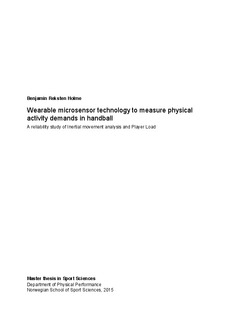| dc.description.abstract | Purpose: Wearable microsensor technology allows for measurements of physical
activity in team sports. To use this technology with confidence, it is critical to determine
its reliability. Therefore, the purpose of this study was to assess the reliability and
sensitivity of a commercially available microsensor technology to measure physical
activity demands in handball.
Methods: A total of twenty-two elite and sub-elite handball players (age, 22.6 ± 3.7
years; body mass, 84.0 ± 14.2 kg; height, 184.4 ± 12.0 cm; mean ± SD) were included
in the present study. The subjects were instrumented with two devices (Optimeye S5,
Catapult Sports, Melbourne, Australia), and participated either in a laboratory
assessment (n =10) or field assessment (n = 12). The laboratory assessment consisted of
seven different handball specific movement tasks, whereas the field assessment was
conducted in twelve handball-training sessions. Various variables were extracted from
the manufacture’s software (Catapult Sprint, Catapult Sports, Melbourne, Australia)
including Inertial movement analysis (IMA) magnitude and counts, and tri-axial
accelerometer data (Player Load). The reliability between devices and sensitivity was
established using coefficient of variation (CV) and smallest worthwhile different
(SWD).
Results: Laboratory assessment: IMA magnitude showed a good reliability (2.9%) in
well-controlled movement tasks. The CV increased (4.4 to 8.2%) in more chaotic
movement tasks. Field assessment: IMA counts showed a good reliability (CV 2.4%)
when displayed as total counts. However, the CV increased when categorized in low
(2.9%), medium (5.5%) and high (5.6%) intensity bands. Medium/high band
(combined) showed a CV of 3.9%. The CV for low, medium/high and total counts was
less than the SWD. Furthermore, it was observed a good reliability of Player Load
(0.9%), which was less than the SWD.
Conclusion: The reliability of IMA counts was good, given that data were expressed as
low, medium/high and total counts. It was observed a good reliability for Player Load.
The CV of the aforementioned variables was well below the SWD, suggesting that
Optimeye microsensors and its software are sensitive to detect “real and worthwhile”
differences in handball activity. | nb_NO |
